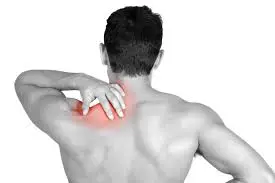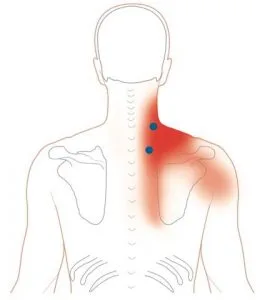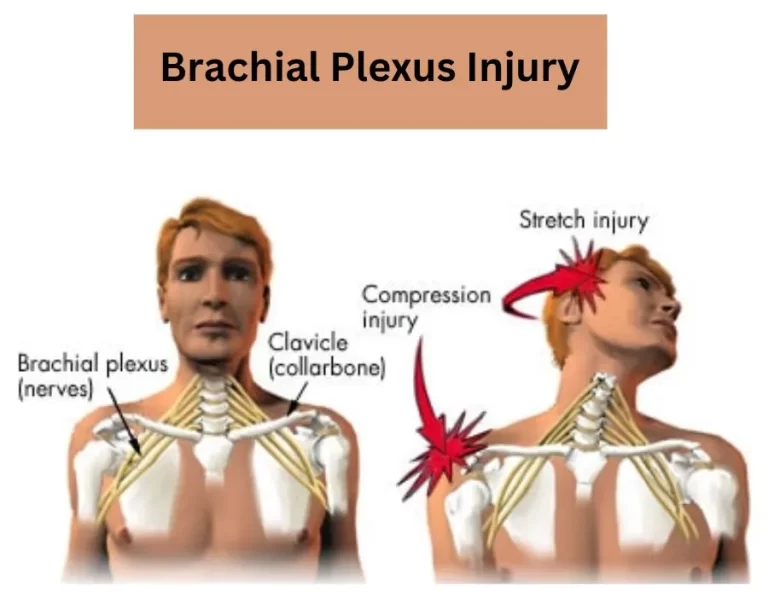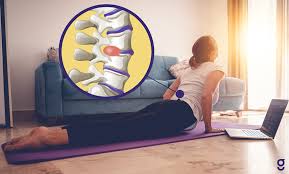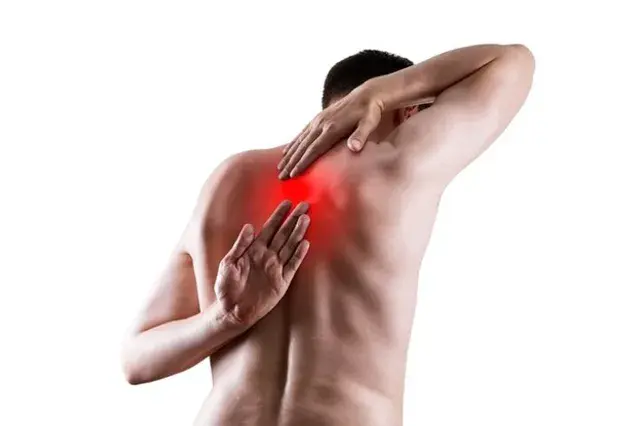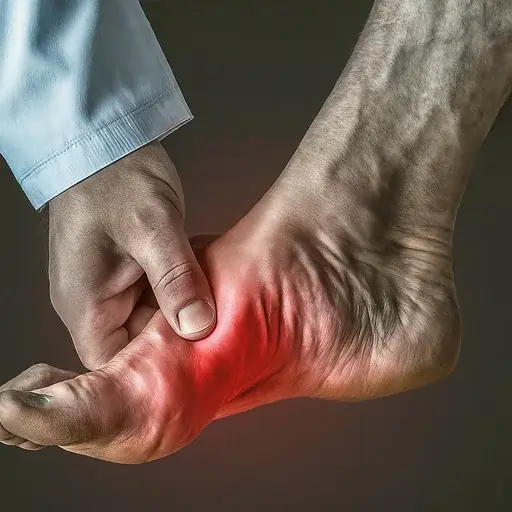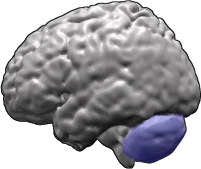Trapezius Muscle Pain
Trapezius muscle pain is a common complaint that can result from various causes, such as poor posture, overuse, stress, or injuries. This discomfort can manifest as a dull ache, stiffness, or even sharp pain, often radiating to surrounding areas like the neck and shoulders.
Understanding the anatomy, functions, and potential causes of trapezius pain is essential for effective management and recovery.
What is the Trapezius muscle?
- Trapezius muscle
- This big, triangular muscle runs from the head to the thoracic spine and then to the center of the back, reaching as wide as the shoulders.
- The location of this muscle is quite near to the skin.
- Each of the superior, middle, and inferior segments of the trapezius muscle contributes to certain motions of the neck and shoulders.
- The movement of the neck and shoulder blade is one of the numerous functions of this big, powerful muscle. This muscle is one of two Trapezius muscles, which are referred to as the human body’s traps.
- In the Trapezius muscle of There is one trap muscle on each side of the neck.
- There are three functional components to this trapezius muscle:
- An upper is the descending portion that bears the arm’s weight.
- The transverse is the central portion that retracts on the scapula.
What is the Trapezius muscle pain?
- The complaint of pain, stiffness, tightness, and spasms in the trapezius muscle is known as trapezius muscular pain. It usually manifests as a shoulder-to-neck ache. Another name for it is trapezius.
- Acute or severe pain that affects many tiny muscles in the neck and upper back is known as trapezius muscle pain.
- Because the trapezius muscle is a flat, triangular muscle that originates at the back of the head and neck, it affects a lot of minor muscles.
- There are several causes of trapezius muscle pain, including muscular strains, nerve injury, and muscle tightness.
- Poor posture causes this muscular soreness.
- The patient experiences arm and neck muscular weakness. muscular tingling sometimes.
- With proper posture, the RICE principle relieves this pain at home.
- The physical therapist’s stretching and exercises assist in easing this pain.
What causes the Trapezius muscle?
Muscle strains:
- Accidents, excessive usage, and intense training can cause the trapezius muscle to stretch too much and tear.
- The lower back muscles known as the trapezius are impacted by back strains and spasms.
Nerve damage:
- if the shoulder and neck nerves that govern the trapezius muscle are damaged.
- This is a rare kind of damage that can happen after neck surgery, such as when a tumor is removed.
- In extreme situations, the whole Trapezius muscle becomes paralyzed.
Tightness & pain:
- Tightness in the trapezius muscle is caused by bad posture, such as sitting at a computer with your shoulders slumped for extended periods of time.
- People who spend several hours a day in front of a computer for work are more likely to develop chronic shoulder and neck pain.
- Shoulder strain is the cause of headaches, particularly when the nerve that regulates the Trapezius muscle is compressed by the tense muscles.
Body posture:
- Bad posture becomes too permanent if it is not treated at an early stage.
- Inappropriate sitting or standing causes pain in the trapezius muscles, which radiates to the spine and supports the muscles by means of the spinal vertebrae.
- so that maintaining uncomfortable sitting and standing postures causes muscular soreness, which is felt in the trapezius muscle.
- Another name for it is repeated stress injury.
Excessive stress:
- Tension causes the muscles to become too tight, especially the trapezius muscles when they are under stress.
- The main cause of it is excessive muscular contraction, which results in pain and soreness in the muscles.
- Anxiety and mental pressure, which frequently accompany difficult times, also exacerbate these symptoms.
Muscle injury/pulled muscles:
- This happens when an injury causes the muscle to be pushed too rapidly and too far.
- This ailment results in a link between the muscles, causing pain and a reduction in range of motion.
Pressure:
- Pain is a result of applying too much or too tight pressure to the trapezius muscle.
- Wearing a bulky backpack, shoulder luggage, and even tight bra straps is the cause.
Accidental/severe injury:
- Acute traumas such as whiplash, which happens when the upper body is abruptly jerked back and forth, and direct head injuries are the causes of this trapezius muscle pain.
- The forward pressure on the trapezius muscle is caused by the forceful snapping of the head backward.
Overuse:
- They experience pain in their trapezius muscles when they engage in repetitive activities, such as swimming or carrying heavy things.
- Individuals who engage in repetitive tasks involving the neck and shoulder muscles are more likely to have pain in their trapezius muscles.
- Retail employees who move bulky boxes and bags, construction workers who carry big goods, and nurses who raise and turn patients are a few examples.
Symptoms of Trapezius muscle pain?
- Patients experience neck and upper back pain in all circumstances.
- The patient has pain or soreness.
- Having trouble completing everyday chores that involve arm movement
- Feel the muscular tightness and neck ache.
- A feeling of tingling and numbness
- Additionally, the patient experiences shoulder pain and muscular stiffness.
- Pain in the interscapular region
- Headaches in the back
- The patient experiences arm weakness.
- The patient feels warm over the painful spot.
- Problems focusing
- Spasticities in the muscle
- Observe the affected area’s swelling during the observation.
At what point should the patient call the physician?
- See a doctor if using home cures to relieve pain doesn’t work.
- In other situations, the patient must call the doctor in an emergency.
- If the patient experiences pain for longer than a week
- Sweating excessively
- Excruciating agony
- Unintentional weight loss
- loss of bladder and bowel function
- Unbalanced
- The patient’s neck and shoulder cannot be moved.
- Additionally, the patient may exhibit symptoms of infection, including fever, chills, and redness of the skin.
- A shaky step.
What is the treatment of Trapezius muscle pain?
The RICE approach is used to reduce the initial period of muscular pain.
- R-rest = After experiencing muscular pain, the patient takes a break and stays away from activities that exacerbate the pain, such as using a computer or performing other strenuous tasks.
- I-ICE = For 20 minutes, ice is applied to the painful location to relieve pain and swelling. The patient is also accustomed to using frozen ice and ice packs.
- C-Compression is used when applying a compression bandage to the triceps muscle.
- E-Elevation: raise a portion of the edema using a cushion to help reduce it.
Non-steroidal anti-inflammatory drugs – NASID
- Use these medications for topical creams and over-the-counter pain medicines that help lessen trapezius pain.
- Popular non-steroidal anti-inflammatory medicines (NSAIDs) for pain management include acetaminophen/paracetamol, naproxen (also known as Aleve), ibuprofen (often known as Advil), and Motrin.
- Diclofenac is another kind of NSAID medication that is applied topically to the affected region as a gel.
- However, NSAIDs should not be taken by pregnant women or patients with specific medical disorders.
Taping:
- applied to the painful region using kinesiology tape
- By wrapping this elastic tape over the sore spot, the strain on the muscle is lessened.
- Numerous studies have shown that tape relieves pain.
Dry needling:
- One method for easing pain is dry needling.
- Using this method, tiny, short needles are inserted into the skin to target particular trigger sites.
- This reduces pain and releases muscular knots.
Relaxation:
- After experiencing pain, patients occasionally use relaxation techniques, such as self-massaging with oil.
- with the assistance of several minutes of light finger massaging around the neck.
- As an alternative, mild heat is also provided for ten to fifteen minutes by using a heating pad [hot pack], a wet warm cloth, or a warm shower.
Electrotherapy
- Use US = Ultrasound to apply to the sore spot and reduce edema.
- Transcutaneous electrical nerve stimulation (TENS) and short wave diathermy (SWD) are used to relieve pain and lessen spasms.
- when numbness is evident with current IFT usage.
Stretching for the Trapezius muscle:
- Cat stretch
- Ear-to-shoulder
- Hug stretch
- Crocodile pose
- Cobra pose
Cat stretch:
- All four limbs on the floor are in the starting posture.
- Next, take a breath, tighten your abdominal muscles, and lift your spine toward the sky.
- For 30 seconds, maintain this stretching position.
Ear-to-shoulder:
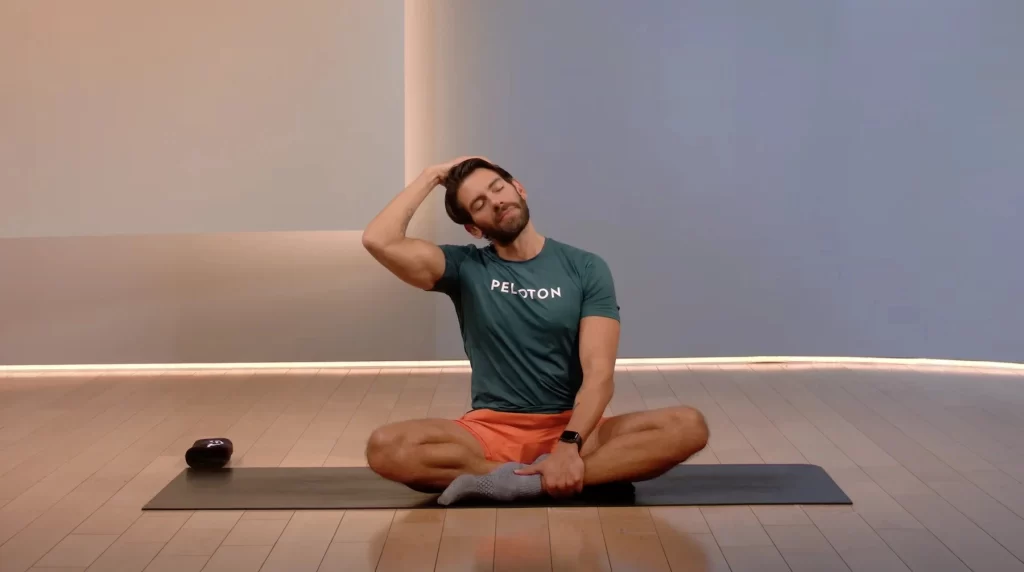
- Sitting is the ideal posture for stretching.
- Straighten up and settle into a chair.
- The head should then be slowly bowed to the left as if the left shoulder were being used to contact the left ear.
- For 30 seconds, maintain this stretching position.
- After that, release your head and extend your right side in the same manner.
- Stretch your ears to your shoulders three times in a single session and three times a day.
Hug stretch:
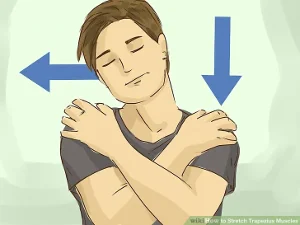
- The standing position is the starting position.
- The patient is straightening up.
- Holding the right shoulder with the left hand while stretching the opposite side will accomplish this.
- Perform this hug stretch three times in a single session and three times daily.
Crocodile pose:
- Another name for it is Makarasana.
- The patient first finds this stance to be excessively unpleasant.
- The goal is to imagine and concentrate on stretching the spine and releasing any tension in the upper back and neck, even though it is released to relieve lower back tightness.
- After that, the patient is led to a place where they can try to relax and take deep breaths.
- Do this crocodile stance three times in a single session and three times per day.
Cobra pose:
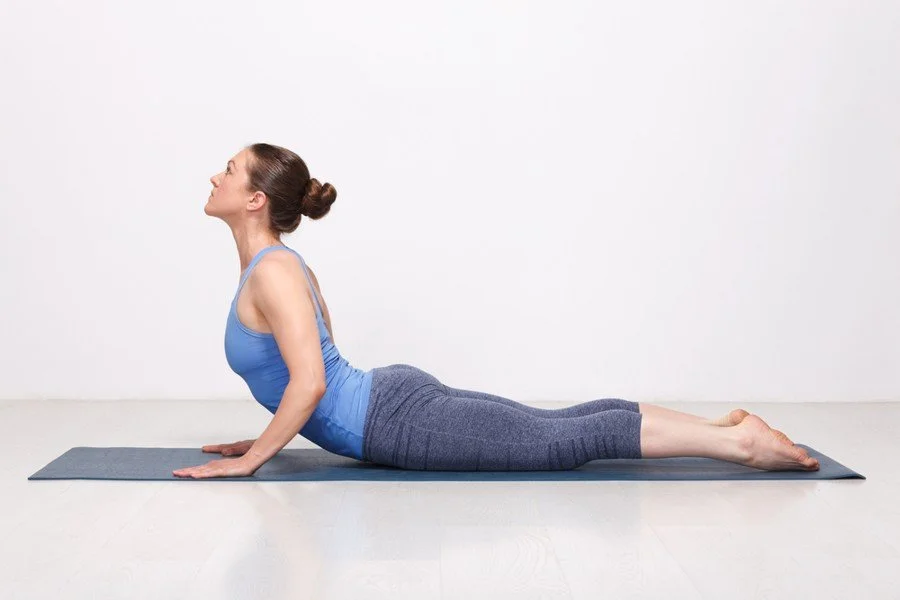
- Another name for this is the Bhujangasana.
- Raise the head and position the hands beside the shoulders on the floor, making sure the elbow joints are close to the body and the arms are parallel.
- As they start to raise their heads and chests, press the tops of their feet into the ground and take a deep breath.
- Straighten your arms as much as you can, but bear in mind that doing so will cause your back to arch significantly.
- To ensure that the neck, head, and cervical spine curve in the same direction, it is important to consider if the lift is intended to straighten the arms.
- The patient wishes to just relax, but they also raise their head.
- Examine the chin.
- Take a minute to roll your shoulders back and down, bringing the shoulder blades closer together as you draw your chest through your upper arms, and then ease your chin back. It’s quite typical to just leave your chin out in this posture and let your shoulders creep up near your ears.
- After that, take another breath or repeat this stance at least twice, holding it for a little while longer each time.
Exercise for Trapezius muscle pain:
- Shoulder blade squeeze
- shoulder Shrug exercise
- Upright row
- Push-up
Shoulder blade squeeze:
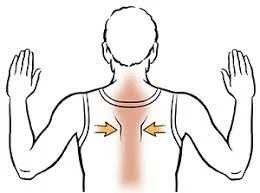
- The patient stands with proper posture during the workout.
- The shoulder blades should then be slowly released to return to their relaxed positions.
- Additionally, a resistance band, cables, and a goal post posture with the arms extended are used for this workout.
- Perform this shoulder blade squeeze exercise three times a day and ten times in a single session.
Shoulder Shrug exercise:
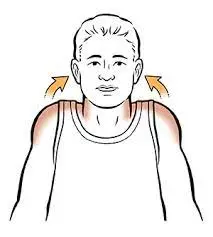
- The patient stands up with proper posture for the workout.
- Next, try to contact the ears with the shoulders by raising them as high as you can.
- For 30 seconds, hold this workout.
- Following that, relax and release the posture.
- Perform this shoulder shrug exercise three times a day and ten times in a single session.
Upright row:
- The patient is standing up straight for the workout.
- Keeping the hands near the front of the body, tighten your fists and then raise them as high as you can while bending your elbows.
- For 30 seconds, hold this workout.
- Following that, relax and release the posture.
- Perform this shoulder shrug exercise three times a day and ten times in a single session.
Push-up:
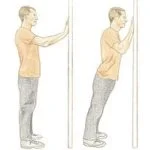
- The patient is standing up straight for the workout.
- Then, while maintaining a taut stomach and a straight back, lower your body toward your hands.
- Keep the patient’s neck in alignment with the rest of their spine and avoid letting their head sink.
- Next, lower the body until it is near the wall or floor.
- Push yourself back into an upright position after that.
- The patient inhales to descend and exhales to ascend.
- For 30 seconds, hold this workout.
- Following that, relax and release the posture.
- Perform this shoulder shrug exercise three times a day and ten times in a single session.
Home care & treatments of the Trapezius muscle pain:
- Applying heat and ice to the sore spot is another natural remedy.
- Muscle pain is lessened by both heat and cold treatment.
- While applying heat decreases muscular spasms, improves blood flow to the region, and speeds up healing, applying cold minimizes inflammation.
What is Ergonomics for Trapezius muscle pain?
- Reducing Trapezius pain can be achieved with an ergonomic examination.
- For instance, always use forearm support when working at a desk to assist in maintaining a neutral and relaxed shoulder position, which lessens the activation of the trapezius muscle.
- Take muscle relaxants: Prescription medications that lessen muscular pain and spasms are available for use.
How to Prevent Trapezius muscle pain?
- Throughout the day, keep your posture correct to reduce any tension on your neck.
- To prevent uncomfortable postures, place the job at eye level.
- Encourage pain-free mobility while experiencing pain.
- The neck gets excessively rigid after an accident, so begin using little motions right after.
- This helps to prevent the muscles from getting too weak, lessen pain from swelling or muscular spasms, and restore the complete range of motion, or ROM.
- Every 30 minutes, take a short break and perform range-of-motion or stretching activities.
- The patient has to be using a firm mattress to sleep on.
- Maintaining the neck’s alignment with the spine is beneficial.
- Avoid sleeping on your stomach.
FAQs
How does a tumor in the trapezius manifest itself?
The tumor is largely painless, exhibits swelling in its early stages, and has no particular symptoms. Depending on the tumor’s location, several symptoms may appear as it grows, including pain, bowel or urine blockage, and a restriction in joint range of motion.
Which medication works best for trapezius pain?
For pain from a trapezius strain, medications including acetaminophen (Tylenol), naproxen (Aleve), and ibuprofen (Advil, Motrin) might be beneficial. Based on your medical history, it’s critical to confirm that you can take these drugs safely.
Can pain in the trapezius be connected to the heart?
Chest pain that radiates to one or both trapezius muscle ridges is the most common symptom of acute pericarditis. Widespread ST-segment elevation accompanied by an audible friction rub is frequently observed as a sign of subepicardial myocardial involvement.
How can I treat pain in my trapezius muscles?
When you sit at your desk, do you get trapezius pain? Take a moment to pull your shoulder blades down and back every 30 minutes. To receive the most relief, press your shoulder blades all the way down and raise your shoulders all the way to your ears.
What is trapezius muscle weakness?
Injuries to the spinal accessory nerve, which powers the trapezius muscle, are often the cause of muscular weakening and atrophy. Following neck surgery (such as lymph node biopsy, parotid surgery, or carotid surgery), this nerve may sustain damage.
Does pain in the trapezius disappear?
A more severe muscle rupture might prevent you from using a shoulder or arm for months, while a trapezius strain might keep you out of commission for a few weeks.
Does heat help with pain in the trapezius?
According to our research, trapezius MPS may be effectively treated with both DN and DN heating therapy, with DN heating therapy showing superior long-term results than DN therapy.
How can I treat pain in my trapezius?
Muscle pain may be lessened with both heat and cold treatment. While heat can lessen muscular spasms, improve blood flow to the region, and aid in healing, applying cold can reduce inflammation.
Can pain in the trapezius be caused by anxiety?
Muscle tightness is not directly caused by stress, worry, or mental health, however, these factors certainly affect our neurological system and how we perceive pain. Because your brain is leveraging an existing pain loop rather than starting a new one, you experience greater pain here when stress and anxiety levels are higher.
Can pain in the trapezius be caused by bad posture?
Debilitating pain in the trapezius muscles can impair function and quality of life. Muscle strain, excessive usage, or bad posture can all cause the pain.
Which vitamin deficit results in soreness in the trapezius?
Overuse, bad posture, inactivity, and vitamin D deficiency are frequently the causes of trapezius muscle pain. To treat severe trapezius spasms or discomfort, the physical therapist may apply infrared heat, transcutaneous electrical nerve stimulation (TENS), or ultrasonic heat.
How severe is trapezius pain?
Maintaining an active lifestyle, stretching often, and maintaining proper posture can reduce your chance of suffering from a trapezius muscle strain, which can be excruciating and restrict your range of motion. A trapezius muscle strain is usually treatable at home, but if the pain is severe or continues, you should consult a physician.
Why does sleeping cause pain in my trapezius?
Patients most often use a head-forward position without recognizing it, which is why they come to us with shoulder pain at night or in the morning. Neck, trapezius, and shoulder pain may arise from this posture’s rounded, leaned-forward stance, which pushes the shoulder forward.
How is the trapezius muscle released?
Simple stretches or yoga postures like Thread the Needle, Eagle, Child’s Pose, and Cat-Cow can help relieve tight traps. Naturally looser trap muscles might also result from exercising to reduce physical and emotional stress and maintain good posture throughout the day.
References
- Ladva, V. (2022, March 13). Trapezius muscle pain: Cause, Symptoms, Treatment, Exercise Samarpan. Samarpan Physiotherapy Clinic. https://samarpanphysioclinic.com/trapezius-muscle-pain/#google_vignette
- Physiotherapist, N. P.-. (2024, February 17). Trapezius muscle – anatomy, origin, insertion, function. Mobile Physiotherapy Clinic. https://mobilephysiotherapyclinic.in/trapezius-muscle/

